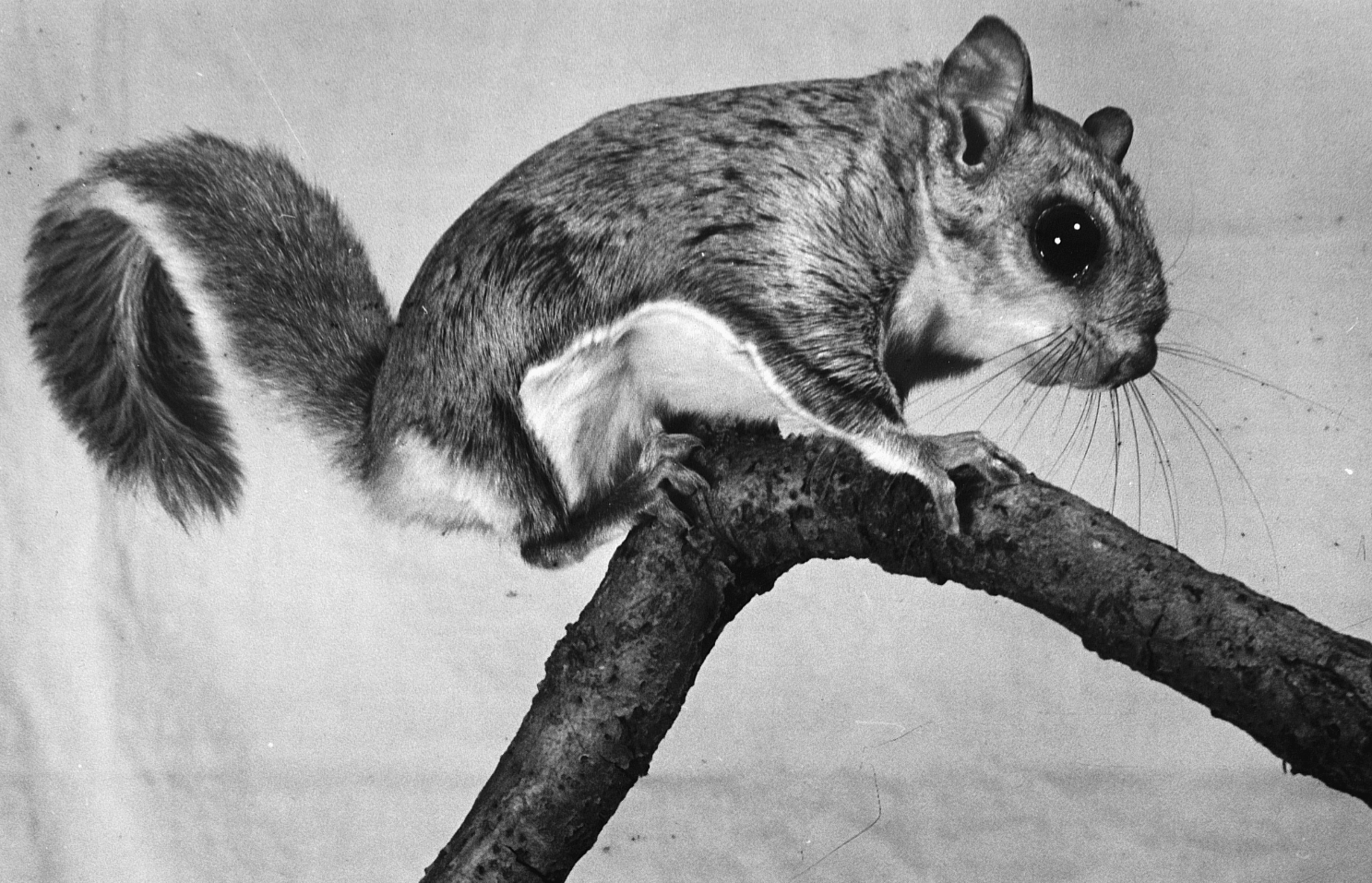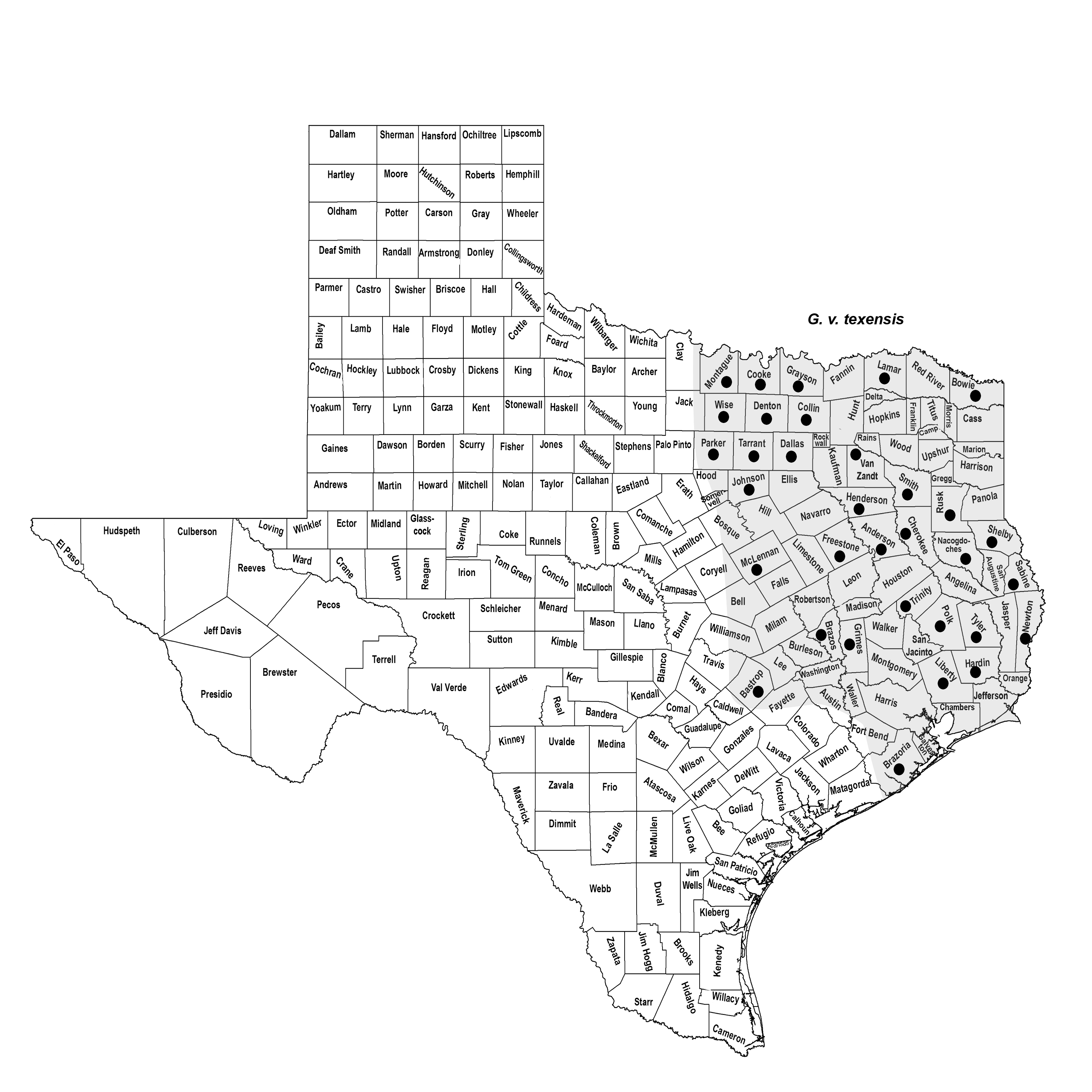SOUTHERN FLYING SQUIRREL
Glaucomys volans (Linnaeus 1758)
Order Rodentia : Family Sciuridae
DESCRIPTION. A small squirrel with flattened, bushy tail; flying membrane connecting front and hind legs; eyes large; upperparts nearly uniform drab or pinkish cinnamon; underparts creamy white; sides often tinged with buff; toes usually strongly marked with white in winter pelage. Dental formula: I 1/1, C 0/0, Pm 2/1, M 3/3 × 2 = 22. Averages for external measurements: total length, 225 mm; tail, 100 mm; hind feet, 29 mm. Weight, 41–67 g.

DISTRIBUTION. Known from wooded areas in eastern one-third of state.

SUBSPECIES. Glaucomys v. texensis.
HABITS. These small, nocturnal squirrels inhabit forested areas where old-growth trees afford suitable den sites. In the western parts of their range, suitable habitat is restricted largely to areas along rivers and streams. In other parts of their range, they show preference for trees covered in Spanish moss. If suitable habitat is available, they may be more abundant than most other squirrels. They are sociable and tend to live together in groups.
Holes in stumps are preferred den sites, but the squirrels will utilize almost any cavity that is dry and large enough. Abandoned woodpecker nests are ideal, particularly those of the larger species. When such sites are not available, the squirrels construct outside nests of leaves and Spanish moss.
They feed on a variety of items, but nuts and acorns are preferred. They also eat insect larvae, beetles, young and eggs of birds, persimmon, and cultivated corn. The frequency with which they are accidently caught in traps set for fur-bearing animals (baited with meat products) suggests a decided preference for meat. Food is cached in holes in trees or other places for winter use.
There are two breeding seasons, the principal one in late February and March, the other in July. However, it is not known if an individual female participates in both the spring and fall breeding periods. Captive females mate only once annually. Males are in breeding condition from late January to early September. Mating is probably promiscuous because several males will chase a female in estrous. The female alone assumes responsibility for rearing the young. The gestation period is about 40 days. At birth, the two or three young are blind, nearly naked, and helpless; they weigh about 3 g. The membrane between the wrist and ankle is well developed. The eyes open at 26–29 days, and a week later the young begin eating solid foods. At 6 weeks of age they are old enough to fend for themselves. They reach sexual maturity when about 1 year old.
Flying squirrels do not actually fly but travel by gliding from one tree to another. This is accomplished by stretching the legs to extend a membrane connecting the front and hind legs. Glides are usually about only 6–9 m in length but may extend up to 30 m (98 ft.).
POPULATION STATUS. Uncommon. We know very little about the population abundance of flying squirrels to predict their conservation status in Texas. They occur in the wooded regions of the eastern part of the state and seem to be especially fond of mature forests with lots of tree cavities and hollow trees.
CONSERVATION STATUS. The IUCN lists the southern flying squirrel as a species of least concern, and it does not appear on the federal or state lists of concerned species. Forestry and timber harvesting practices that eliminate old-growth habitats would be harmful to its long-term status.
From The Mammals of Texas, Seventh Edition by David J. Schmidly and Robert D. Bradley, copyright © 1994, 2004, 2016. Courtesy of the University of Texas Press.
Natural Science Research Laboratory
-
Address
Museum of Texas Tech University, 3301 4th street, Lubbock, TX 79409 -
Phone
806.742.2486 -
Email
nsrl.museum@ttu.edu

